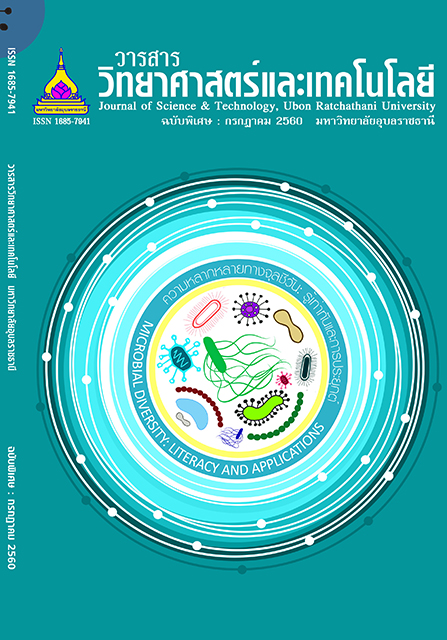การสำรวจคุณภาพและประเมินความเสี่ยงต่อสุขภาพแหล่งน้ำดื่มชุมชน
Main Article Content
บทคัดย่อ
บทคัดย่อ
เนื่องจากบ้านแม่ต๋ำน้อย ตำบลแม่กา อำเภอเมือง จังหวัดพะเยา นับได้ว่าเป็นพื้นที่ที่ห่างไกลความเจริญ สาธารณูปโภคพื้นฐานไม่สามารถเข้าไปถึง งานวิจัยนี้มีวัตถุประสงค์เพื่อสำรวจคุณภาพและประเมินความเสี่ยงของแหล่งน้ำดื่มชุมชนบ้านแม่ต๋ำน้อย และรวบรวมฐานข้อมูลที่เชื่อถือได้พบว่า การตรวจวัดทางกายภาพ ได้แก่ ความเป็นกรด - ด่าง ออกซิเจนละลายน้ำค่าการนำไฟฟ้า ความขุ่น และความกระด้าง ผ่านเกณฑ์มาตรฐาน การตรวจวัดทางเคมี พบว่า ซัลเฟต ฟอสเฟต และไนเตรท รวมทั้งธาตุหลักและจุลธาตุทั้งที่เป็นโลหะและอโลหะ ผ่านเกณฑ์มาตรฐานน้ำดื่ม โดยพบว่า การนำไฟฟ้า ความขุ่น ความกระด้าง ซัลเฟต ฟอสเฟต และไนเตรทในน้ำ มีความเสี่ยงระดับปานกลาง สำหรับปริมาณธาตุหลักและจุลธาตุ ได้แก่ แคลเซียม อะลูมิเนียม สารหนู โครเมียม เหล็ก ลิเทียม แมงกานีส และโมลิบดีนัมมีความเสี่ยงปานกลาง ไม่พบว่าธาตุใดมีความเสี่ยงสูง การตรวจวัดจุลินทรีย์พบว่า ไม่ผ่านเกณฑ์มาตรฐาน มีการตรวจพบโคลิฟอร์ม อีโคไล และค่าจุลินทรีย์ทั้งหมด ในปริมาณที่เกินมาตรฐาน นอกจากนี้พบว่า การตรวจวัดสาหร่ายและแพลงก์ตอนไม่พบชนิดที่เป็นพิษ หรือสามารถสร้างสารพิษที่เป็นอันตรายต่อมนุษย์ ดังนั้นหากชุมชนจะบริโภคแหล่งน้ำนี้ให้ปลอดภัย ควรนำน้ำไปผ่านการปรับปรุงคุณภาพเบื้องต้นได้แก่ การกรองผ่านวัสดุกรองน้ำ เพื่อกรองตะกอน สี กลิ่น สารอินทรีย์ และแร่ธาตุบางชนิด และทำการต้ม เพื่อฆ่าเชื้อโรค
คำสำคัญ : คุณภาพน้ำดื่ม การประเมินความเสี่ยงต่อสุขภาพ
Abstract
The objectives of this research were to assess the water quality and health risks of drinking water in Mae Tom Noi village in Phayao province, a remote location outside the reach of standard infrastructure. Water samples were collected and subjected to physical, chemical, and biological analyses. Physical parameters were measured at in-situ, and biological function included Bacteriological Analytical Manual (BAM) and detection of algae and plankton. Major and trace elements were analyzed by Inductively-Coupled Plasma Optical Emission Spectrometry (ICP – OES) and Coupled Plasma Mass Spectrometry (ICP – MS). Results showed that pH, dissolved oxygen (DO), electrical conductivity (EC), turbidity, and hardness were at acceptable levels, and sulfate (SO42-), phosphate (PO43-), nitrate (NO3-), and major and trace elements were below acceptable levels. The risk assessments of EC, turbidity, hardness, sulfate (SO42-), phosphate (PO43-), nitrate (NO3-) showed medium risks, and the major and trace elements, including Ca, Al, As, Cr, Fe, Li, Mn, and Mo, showed medium risks. However, there were no high risk elements. The bacteriological analysis showed that total coliform bacteria (MPN coliforms/100 ml), Escherichia coli, and total plate counts were more than the allowable values. In addition, investigation of algae and plankton indicated that they were not toxic species and were not harmful to humans. The study recommended that the quality of the drinking water should be improved by filtration through filter material to remove sediment, color, odor, organic matter, and minerals, in addition to boiling for disinfection purposes before consumption.
Keywords: Drinking water quality: Health risk assessment
Article Details
บทความที่ได้รับการตีพิมพ์เป็นลิขสิทธิ์ของ วารสารวิทยาศาสตร์และเทคโนโลยี มหาวิทยาลัยอุบลราชธานี
ข้อความที่ปรากฏในบทความแต่ละเรื่องในวารสารวิชาการเล่มนี้เป็นความคิดเห็นส่วนตัวของผู้เขียนแต่ละท่านไม่เกี่ยวข้องกับมหาวิทยาลัยอุบลราชธานี และคณาจารย์ท่านอื่นๆในมหาวิทยาลัยฯ แต่อย่างใด ความรับผิดชอบองค์ประกอบทั้งหมดของบทความแต่ละเรื่องเป็นของผู้เขียนแต่ละท่าน หากมีความผิดพลาดใดๆ ผู้เขียนแต่ละท่านจะรับผิดชอบบทความของตนเองแต่ผู้เดียว


